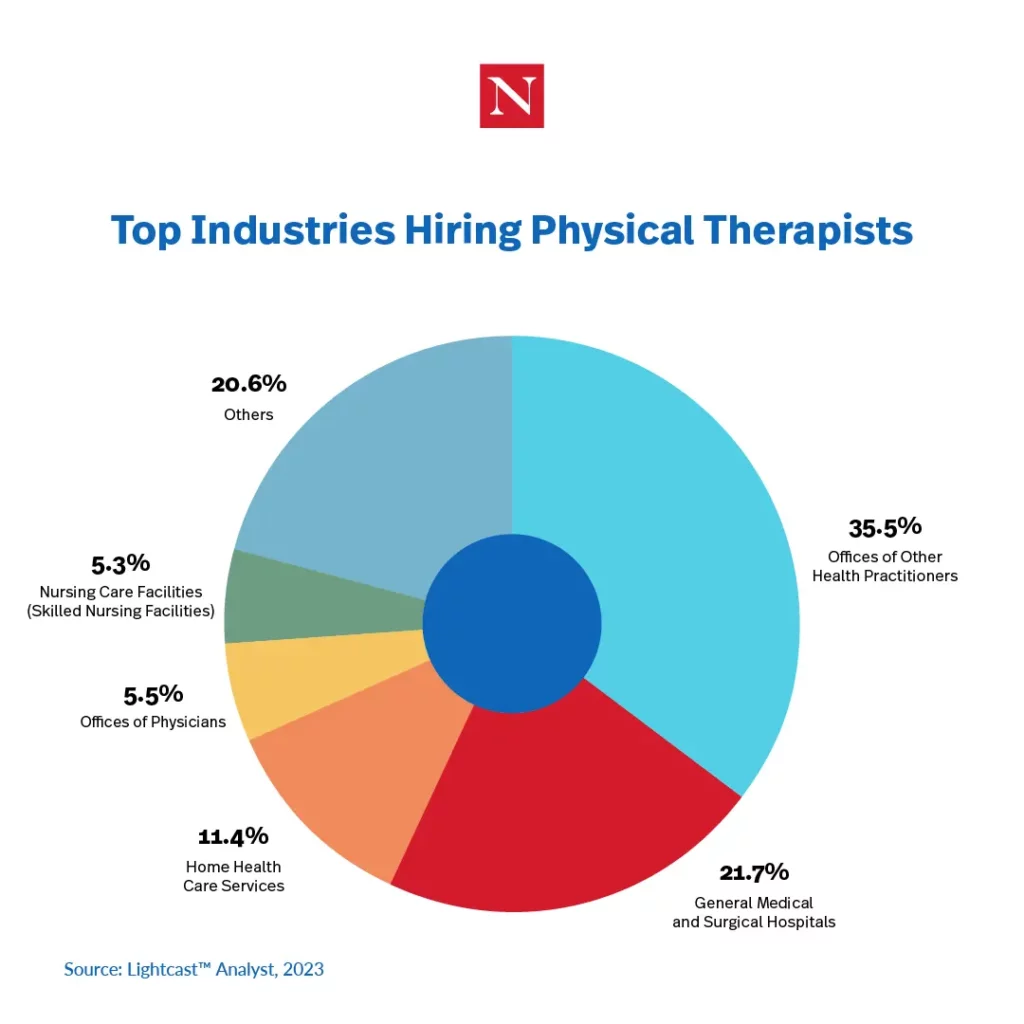While physical therapy has been around for over a century, its role in healthcare is steadily increasing. In recent years, the expanding aging population and the emergence of the global pandemic have contributed to more career opportunities and a heightened national demand. Its popularity goes far beyond its long-term career outlook though.
According to the U.S. News Best Jobs Rankings, physical therapists are ranked #3 in top healthcare jobs, and #6 in their “100 Best Jobs” list. Given the criteria to make these determinations (e.g., salary, job market, future growth, stress level, work-life balance), it’s no wonder a career in physical therapy is a common path for people wanting to make a difference.
If you’re interested in becoming a physical therapist, here’s an overview of what a physical therapist is, what they do, where they work, and what skills you need to succeed in most workplace settings.

Career Guide
Everything You Need To Know About Becoming a Physical Therapist

What Is a Physical Therapist?
According to the American Physical Therapy Association (APTA), a physical therapist (PT) is a healthcare professional who helps people live healthy and active lives. PTs are often considered movement experts who work to improve quality of life through prescribed exercise, hands-on care, and patient education.
“These professionals assist with the pathology of human movement and help patients navigate challenges associated with their orthopedic, neurological, and cardiovascular systems,” says Dr. Christopher Cesario, Associate Clinical Professor and Director of Student Affairs for the Doctor of Physical Therapy (DPT) program at Northeastern University’s Bouvé College of Health Sciences.

What Does a Physical Therapist Do?
For individuals interested in this exciting field, here are the four main responsibilities you can expect as a physical therapist in most workplace settings.
1. Diagnose Physical Impairments
The role of a physical therapist is to help rehabilitate individuals dealing with physical impairments so they can return to their normal activities. When a patient requires physical therapy it means some part of the body isn’t functioning properly, therefore hindering their ability to move accordingly.
“Physical therapists are able to diagnose what structures are injured or what impairments patients have, and determine the treatment that’s needed from a physical perspective,” says Cesario. This can mean working with an athlete to get back on the field after a bone break or assisting an elderly patient to regain physical functionality from a stroke.
While physical therapists specialize in movement-based treatment, this isn’t always the answer. “I think being able to screen a patient and see whether or not physical therapy is appropriate, as well as differentiating if something needs further testing, is essential for most physical therapists,” says Cesario. This means PTs need to be able to view and interpret diagnostic imaging and medical charts to make well-informed decisions.
2. Create Treatment Plans
Much like treatment plans from other healthcare professionals, patients of physical therapists receive a personalized plan of care according to their injury, health conditions, and the unique features of their orthopedic structure.
While every plan of care is different, many patients are prescribed some form of therapeutic exercise rather than solely relying on pharmaceuticals. “One of the terms we use in physical therapy is ‘movement is medicine,’” says Cesario. This means most patients of physical therapists receive treatment plans that incorporate an exercise plan that will stretch and strengthen the affected muscles to help restore function. Physical therapists do use pain relief modalities like a transcutaneous electrical nerve stimulation (TENS) to help reduce symptoms to supplement the exercise program.
3. Provide Treatment
After diagnosing the issue and creating a plan, physical therapists work to administer the prescribed treatment. They typically see patients on a regular basis, working through the plan they developed and making any necessary adjustments based on progress. PTs often keep this pace until it’s determined that a patient’s injury or disability is healed or they have enough education to self-administer minor, ongoing therapy at home.
Since physical therapy treatment often involves constant movement with patients—lifting limbs and assisting with manual therapies when necessary—it’s important that therapists ensure they are in proper shape to keep up with the physical demands of the role. Keep this in mind when entering the field of physical therapy since quality treatment is essential to a patient’s recovery.
4. Educate Patients on Self Care
One of the most important aspects of a physical therapist’s role is educating patients on how they can retain a high quality of life. While many healthcare professions treat injuries, aches, and pains, physical therapy tries to promote long-term lifestyle shifts that can lead to better recovery results.
“I think the general public has this perception that if my back hurts, I should lay down. But physical therapists are going to tell you to move,” says Cesario.
Since physical therapists have such deep knowledge of the body and how it functions, they are the best resource for patients hoping to make necessary lifestyle changes. Helping others better understand their pathology and the reasoning behind certain treatments ensures patients are able to sustain their results after their supervised treatment. Not only that, this information can be incredibly empowering for patients who want a higher quality of life.
Where Do Physical Therapists Work?
While the core duties of a physical therapist are often the same, it’s important to consider what workplace setting you’re interested in, as well. With so many different settings, physical therapists can enjoy a wide range of career options that can affect the day-to-day responsibilities.
According to our analysis of job postings data, the top industries hiring physical therapists include:
- Offices of Health Practitioners or Private Practices
- General Medical and Surgical Hospitals
- Home Health Care Services
- Offices of Physicians
- Nursing Care Facilities

While all of these settings are related to healthcare, each industry offers different workplace dynamics—specifically regarding a physical therapist’s role in the facility. For example, “Settings like a rehabilitation hospital require communicating with the rest of the healthcare team to talk about progress. They may also discuss medication that needs to be changed based on whether physical symptoms are improving or not,” says Cesario.
These daily responsibilities aren’t necessarily guaranteed in workplace settings, such as a private practice or home healthcare services, where there is far less daily communication among healthcare professionals, and more so between the physical therapist and the client. These factors are important to consider since they directly affect the role you’ll play in a facility on a daily basis.
What Skills Do Physical Therapists Need?
The role of a physical therapist is in high demand. According to our analysis of job posting data, there has been a six percent increase in physical therapy graduates from 2020 to 2022. In addition, the variety of settings that leverage physical therapy services has also experienced an influx. As a result, a larger variety of industry skills in this field are in high demand.

According to our analysis of a report that compiles job postings data, the top specialized skills physical therapists need include:
- Rehabilitation
- Treatment planning
- Home health care
- Patient treatment
- Orthopedics
- Discharge planning
- Patient screening/evaluation

According to Cesario, patient education is another essential specialized skill for physical therapists. This makes sense considering one of the key roles of PTs is to educate clients of their treatment and long-term care.
While these industry-specific competencies are important, not all skills required in the physical therapy field are medical-related. This position also requires skills needed to successfully navigate the constant interaction with patients and colleagues.
According to the same report, the top common skills physical therapists need to obtain are:
- Communications
- Coordinating
- Interpersonal communications
- Customer service
- Writing
- Management
- Scheduling
- Computer literacy
- Leadership

Take Your First Step Toward Becoming a Physical Therapist
Physical therapy is a promising career choice with strong job security. Options span different healthcare settings and patient demographics, leaving it up to each individual to decide their desired path.
If you’re interested in becoming a physical therapist, you are required to complete three years of education in a doctoral physical therapy program and obtain licensure. Programs like Bouvé College of Health Sciences’ Post Baccalaureate Doctor of Physical Therapy (DPT) degree provide the background, education, and clinical experience needed to start treating patients immediately. This is an essential step in starting an exciting career in the field of physical therapy.
Download Our Free Guide to Physical Therapy

Career Guide
Everything You Need To Know About Becoming a Physical Therapist





